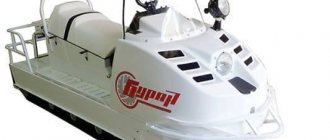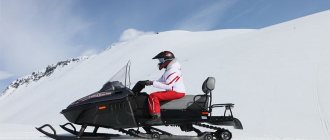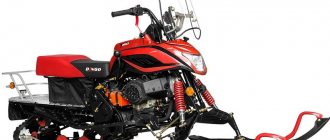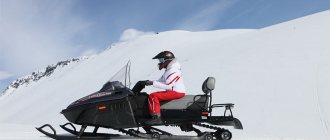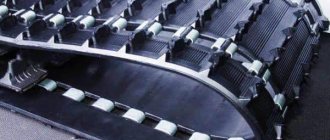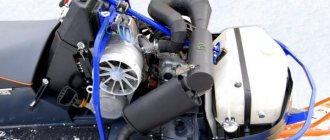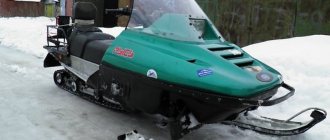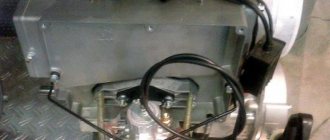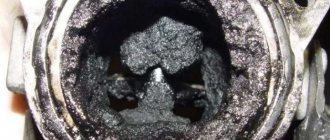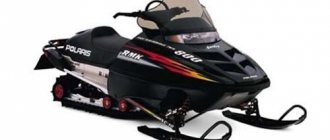Buran snowmobile gearbox diagram
Almost everyone has encountered a broken circuit in the reverse gearbox of a Buran snowmobile or heard about it. As a rule, a circuit break in a box occurs unexpectedly and it is almost impossible to predict when it will happen. It’s very sad to find yourself in the middle of the taiga, far from warm housing in severe frost, and especially to repair equipment in these extreme conditions
Knowing this, experienced users of the Buran snowmobile, capable of making repairs in the field, always have a spare chain with them, which is already prepared for quick installation (riveted). Of course, such events are not pleasant. In addition, everything is complicated by the fact that if the circuit breaks, repair is often completely impossible, because a broken chain often bends the shaft, or cuts off the teeth of the sprockets, or, even worse, breaks the gearbox housing like a whip.
Let's try to answer the question, why does this powerful, utilitarian snowmobile, which has unsurpassed traction properties and is loved by hunters and fishermen, experience gearbox chain breaks with enviable regularity!? In the article, Buran gearbox or which chain to choose?! we will dwell on some aspects of this unpleasant situation and tell you which circuit to give preference to when carrying out repair work
A little history of the modernization of the Buran reverse gearbox. Previously, in the reverse box of snowmobiles produced in the 70s of the last century, a double-row bushing chain with a pitch of 12.7 mm (2Pr-12.7-3200) consisting of 70 links was installed. Visually, this chain looks more powerful than its successors. By the beginning of the 80s, the so-called old-style chain (2ПВ-9.525-1700) with a pitch of 9.525 mm began , which, according to manufacturers, is characterized by increased manufacturing accuracy, a smaller pitch and the absence of a chain lock, which provides increased smooth running and reduced chain drive noise. And what is especially important is that it significantly increases the operational reliability of the unit (according to the manufacturer). Next, a chain of a new type (2ПВ-9.525-2000) with the same pitch takes over the baton. Like its predecessor, the new chain is designed to increase the reliability of the reverse gearbox
Let's look at the characteristics of these circuits and try to figure out whether the implemented modernization really improved the reliability of the node. The main indicator of chain quality is the minimum breaking load (kN/kgf), so a chain with a pitch of 12.7 mm breaks at a load of 31.8/3180, “old model” -17.0/1700, “new model” -20.0 /2000. From which it is clear that the very old chain is significantly superior to its rivals. And according to experienced snowmobilers, it was very reliable, which is confirmed by real runs without any breaks.
Today, most snowmobiles are equipped with “new style” chains. At the same time, snowmobiles with old-style chains in the gearbox are also common. Let's look at them in more detail. Externally, the double-row chain of the “old” and “new” samples is easily distinguishable by the shape of the side plates. The “old style” chains have a “rectangular” side plate shape, while the “new style” chain plates resemble a figure eight (∞). In addition, these chains differ in the diameter of the bushing (roller), which makes them not interchangeable
According to the characteristics declared by the manufacturers (break resistance), the chain of the “new type” is more reliable, however, the design flaw in the cheeks of these chains (∞) increases the likelihood of side teeth biting the sprockets. In turn, the “old style” chain, having less strength, is more reliable due to the “rectangular” shape of the side plates. The likelihood of these chains being bitten is an order of magnitude lower. And this is proven by practice.
Analyzing the changes that have occurred with the Buran snowmobile, we can confidently say that since the increase in engine power from 28 hp. up to 34 hp and the introduction, as the chains claim, the gearbox rightfully began to be considered one of the most vulnerable components of the Buran snowmobile! But let's not be discouraged, because... Today, snowmobile owners have the opportunity to install sets of three-row chains and double-row chains of the European, American or Japanese series on their pet. According to the stated characteristics of the manufacturers (minimum breaking load), they are not inferior to domestic ones, but in fact they are superior to them, and they also have greater fluidity upon destruction, i.e. do not burst immediately, but seem to reluctantly stretch, gradually pushing the roller (finger of the link) out of the mounting holes
Reasons leading to breakdown
| 1 | The machine was not used for a long time and was stored incorrectly. |
| 2 | The motor always operated at low temperatures. |
| 3 | When pouring fuel, water condensate from metal containers entered the system. |
| 4 | During operation, some equipment components turned out to be wet, they were affected by water and low temperature. |
| 5 | The tracked propulsion functioned with greater loads than the wheeled one. |
| 6 | The gearbox and transfer mechanisms are worn out. |
| 7 | The steering loads were greater than those of wheeled vehicles. |
Buran gearbox with low gear!
Veteran
Full name: Combined filling in the Buran gearbox with reduced transmission through a three-row chain made in Germany.
Author of the idea, Volodya from Severodvinsk (Bob 292). The history of creation is as follows. Volodya developed the design itself, in metal. Sent to me, installed in the gearbox and tested. Removed, given to a designer-technologist to develop manufacturing technology using the existing equipment of a manufacturer engaged in the manufacture of VAZ sports boxes and develop drawings for this business. It took quite a lot of time, as it was originally planned and The production of a gear box began. But due to difficulties in the form of the cost of a new housing and the difference in center distances at each snowstorm, we were forced to abandon this idea. As a result, the following design was created. This option is for the new model body:
An option has also been developed for the old-style body, with a speedometer on the right. I would like to immediately point out that in view of the space inside the gearbox housing is quite small, and the gears need to be placed, VAZ cementation technologies were used and the appropriate grades of metal were used. Rybinsk, Izhevsk, and Chinese “samovar” will not work here. In addition, special treatment of the gears was used, before cementation, for “soft” gear engagement. Also, the fit of the gears on the shafts was thought out, based on the experience of the Installer operating a prototype gear box. Using the appropriate type of bearings. In general, there were quite a lot of secrets. And simple “duplication” will not lead to anything good. Another photo: this is almost a complete set. Housing not included. Well, these are just shafts, with other components:
Please do not write all commercial questions in this topic. There is a commercial section for this. This one contains only technical questions.
Source
Buran snowmobile gearbox diagram
The snowmobile's transmission consists of a V-belt variator and a reverse gearbox with a chain drive.
The variator (Fig. 4) is a V-belt transmission with automatic change in the working diameters of the drive and driven pulleys using a centrifugal regulator when the engine speed changes and a cam load clutch when the resistance to movement of the snowmobile changes.
The main parts of the variator include a drive pulley with a centrifugal governor mounted on the engine shaft, a driven pulley with a load cam clutch on the drive shaft of the reverse box, and a belt.
The drive pulley consists of a fixed cone 6 and a bearing 9, a bushing 19, a spring 8 and a centrifugal regulator mounted on it. The tightening torque of the fixed disk is 8.10 kgf m. The internal cavity of the fixed disk shaft is filled with grease through the threaded hole for the regulator fastening bolt.
The driven pulley consists of a fixed disk 21, a movable disk 1, a return spring 22 and a coupling half 3. The coupling half is held on the shaft from turning by a key 2. When the variator is operating, the liners 5 of the coupling half slide along the helical surface of the movable disk. The spring is located between the coupling half and the moving disk and is pre-loaded and twisted by 120°. The split ring 28, secured to the shaft by a spring ring 29, serves as a limiter for the movement of the movable disk to the stationary one and at the same time as a stop for the stationary disk, fixed to the shaft with a key 23, a washer 26, a locking washer 25 and a bolt 24. Adjustment rings 27 are installed between the split ring 28 and the fixed disk 21 to obtain the required size between the disks of the driven pulley. To remove the fixed disk, it has three threaded holes.
Adjusting the fuel level
This is done by adjusting the floats in the float chamber. Unscrew the bottom of the float chamber and remove the float. First of all, you need to check the tightness of the float. They immerse it in water and see if there are any bubbles. Then they look at approximately what level the float is. Normally, this is 13 mm from the bottom of the float, approximately in the middle. The size is measured with a caliper. If this figure is different, bend the float tongue in one direction or another.
Description of the Buran snowmobile gearbox
What spare parts does the Buran snowmobile gearbox consist of, its detailed diagram and description - read about it in our article.
The gearbox of the Buran snowmobile is designed to transmit torque from the drive shaft of the box to the shafts of the drive sprockets of the tracks, change the speed of movement, reverse the snowmobile and disconnect the engine from the chassis.
The gearbox (Figure 3) consists of a housing, a crankcase, a drive shaft, a reverse shaft, a shift mechanism and a chain drive, which includes:
- forward and reverse sprockets;
- driven sprocket;
- chain tension mechanism;
- drive chain (96 links).
The gearbox mechanism, with the exception of the driven sprocket 10, installed in the crankcase 9 on the splined ends of the drive shafts of the chassis, is mounted in the gearbox housing.
The drive shaft 4 rotates on two bearings 1 and 6. On the drive shaft, in addition to the variator driven pulley assembly, the following are installed: a rubber sealing collar 7, a drive sprocket 5 in a block with a gear on needle bearings, a reverse gear 2 on a needle bearing, a gear shift gear 4 with double-sided cams, washers, with the help of which the axial play of the sprocket is adjusted. The reverse shaft 14 is installed in the housing on two bearings 12. A sprocket 16 and a gear 13 are pressed onto the shaft, a gear block 15 and a cuff 11 are installed. The speedometer drive gear is integral with the shaft.
The gearbox switching mechanism is mounted in the housing cover and consists of an axis 17, a shift fork 19 with a spring-loaded ball 18, which fits into one of the four grooves of the axis when switching, and a shift lever 20. A lever 21 is installed on the top of the shift lever axis. A plastic plug is screwed into the cover with venting hole. The chain tension mechanism is located in the lower half of the housing and consists of a tension shaft 24 and a sprocket 22 rotating on a needle bearing. The chain tension is adjusted by turning the tension shaft. In the required position, the shaft is locked with a bolt 23. An inspection window, closed with a rubber plug 25, is provided for checking the tension of the chain 26, as well as for checking the oil level in the crankcase.
The gearbox is controlled by a manual drive, consisting of a shift handle and a rod connecting the handle to the shift mechanism lever.
Adjusting the K65zh carburetor
Before adjusting the K65Zh carburetor on the Buran snowmobile, you need to install it, connect the gas cable to the carburetor lever, and the magneto cable to the starting plunger. The throttle should lift the throttle all the way, but it should idle about half a turn. This is necessary so that when turning the steering wheel with a natural displacement of the hand, it does not affect the gas. In addition, adjusting the K65zh carburetor on the Buran-640 snowmobile may not be necessary, since it is equipped with a slightly different, Japanese Mikuni carburetor.
